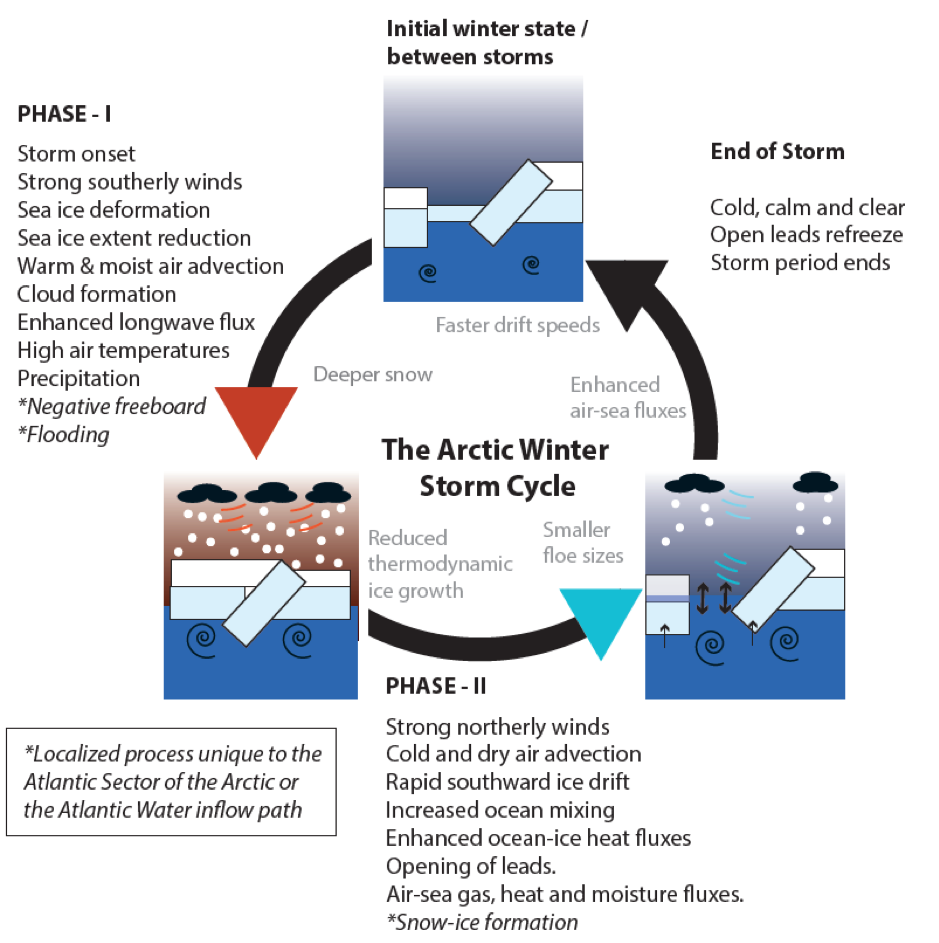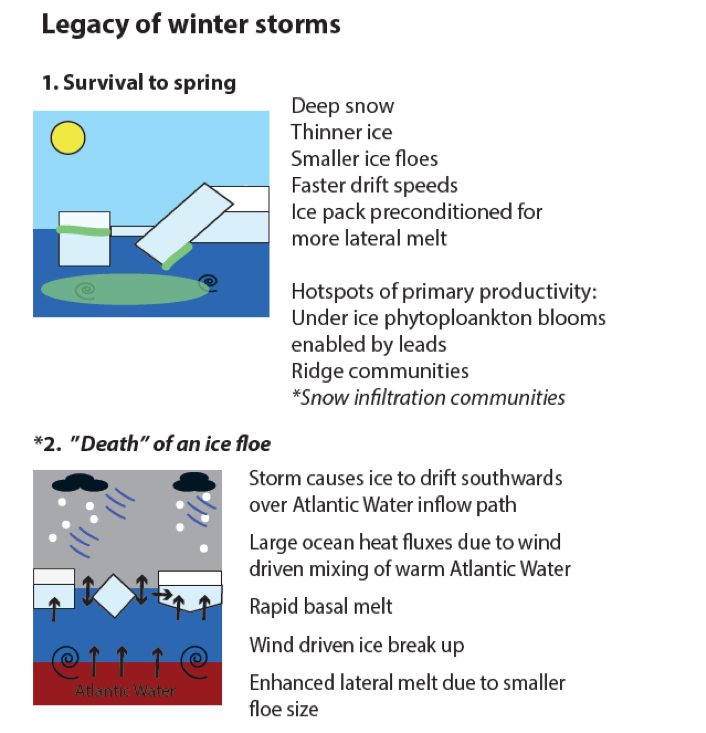Picture: Polar bear on ice flow. Credit: Marcos Porcires
Winter sea ice in the Atlantic sector of the Arctic has been retreating at a record-breaking pace since 2015. Today the Arctic sea ice extent is 1/4 smaller than the 1982-2010 average, and thickness has dropped from ~3.5 meter in the 80s to ~1.5 meter.
Understanding the dynamics of this ‘new’ thinner Arctic is vital for predicting what will happen (and when) to the remaining sea ice and its rich ecosystem. This can be complicated because many of the observations in the Arctic date back a few decades when sea ice was thicker and older.
This new study combines observations across disciplines of the ‘new’ Arctic to synthesise the mechanisms that lead Arctic winter storms to impact sea ice.
This research identifies interactions between the sea ice and the atmosphere, ocean and snow.
The researchers found that winter storms transport pulses of heat and moisture into the Arctic atmosphere, which momentarily stops ice growth.
However, ice growth does not resume after these short storms. Instead, snow deposited during these storms settles on the ice and insulates it from the cold atmosphere. This results in a reduction in ice growth throughout the entire winter season.

Figure – The Arctic winter storm cycle: Schematic of processes related to Arctic winter storms. In the first storm phase, strong southerly winds compress the ice cover and transport atmospheric heat, moisture, and precipitation into the Arctic. The atmospheric warming temporarily slows ice growth, and snow accumulation effectively inhibits bottom ice growth throughout the remaining winter season. If the snow load is sufficient to induce negative freeboard, snow may be flooded along the cracks in the ice during a storm. This flooded snow may then refreeze, forming snow-ice. In the second phase, northerly winds transport ice southwards towards an unconstrained ice edge. The rapid drift opens numerous leads, allowing intensive air-ocean gas and heat exchange and strong upper ocean mixing, resulting in enhanced ocean heat fluxes. Along the Atlantic Water inflow path, storms mix up heat from warm subsurface waters and effectively melt large volumes of ice even in winter. After the storm has passed, cold and calm conditions return, allowing new ice to grow in leads. When the next winter storm arrives, it further drives the ice cover into a relatively thin-ice, snow-covered mosaic of strongly deformed ice floes that also impacts ice-associated ecosystems by shaping habitats and light conditions.
But it doesn’t stop there, strong winds during these storms also break the ice into smaller floes that drift faster, which weakens the ice floe for the rest of the season.
In addition, the northerly winds that often appear towards the end of storms, accelerate the transport of thicker-older ice in the Transpolar Drift towards warm Atlantic Water, a current that flows into the Arctic at depth. As this older, thicker ice drifts over the Atlantic Water inflow path, storm-driven ocean mixing brings heat from the warm water below, up to the sea ice, melting it from below, even in mid-winter.
As a result, the cumulative effect of frequent winter storms in the Atlantic Sector of the Arctic Ocean leads to a thinner, weaker, and younger snow-laden ice-pack.
The Atlantic sector of the Arctic currently experiences the most frequent and strongest winter storms. These storms are likely to increase in number in a warmer Arctic, increasing the impact on the ice. This increase occurs because with thinner sea-ice cover and warmer and shallower Atlantic Water, the air-snow-ice-ocean coupling observed during storms will strengthen.
As a result, in the future we can expect more sea ice break-ups and ridging, more leads, greater ocean heat fluxes and faster melt in response to winter storms. Arctic storms may be short but the legacy they leave for sea-ice and the sea ice ecosystem goes far beyond their short lifespan.

- Paper: Graham, R. M., P. Itkin, A. Meyer, A. Sundfjord, […] M. A. Granskog et al. (2019). ‘Winter storms accelerate the demise of sea ice in the Atlantic sector of the Arctic Ocean.’ Scientific Reports 9(1): 9222. https://doi.org/10.1038/s41598-019-45574-5
